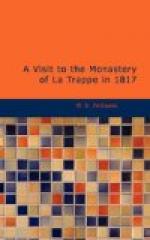It was at different times the residence of Louis XIII.[17] of Anne of Austria, Christiana of Sweden, and of Madame La Valiere, when Madame de Montespan rivalled her in the affections of Louis XIV. After the former had retired to the Convent of the Carmelites at Paris, it was assigned in 1689 to the unfortunate James the Second, whose bigotry had driven him from the throne of England. Here, together with his Queen, and those of his court who fled with him to seek an asylum in France, and surrounded by those priests and monks, whose pernicious councils had led to his fall, the unhappy James remained until his death, the 16th Sept. 1701. The apartment in which he breathed his last is still preserved; but the whole of the interior has been very much neglected. It served as a quarter for a body of Prussians in 1815, and the following year was a barrack for the English troops quartered at St. Germain. A French poet of his time wrote these lines descriptive of the life he led in his retirement.
“C’est ici que Jacques second,
Sans Ministres et sans maitresse,
Le matin allait a la Messe,
Et le soir allait au sermon”.
[Footnote 16: On the top of this height is the Pavilion de Lucienne, built by Madame Dubarry, Mistress to Louis XV. afterwards the property of Madame La Princesse de Conti, now the residence of M. de Puy: at the foot is the village of Lucienne, surrounded by numerous villas: among the most remarkable is the residence of General Comte Campon.]
[Footnote 17: Lewis XIV. would not reside here, because the steeples of the Abbey of St. Denis, where he was to be interred, could be seen from the Chateau. The amount of the immense treasure which the consequent erection of the Palace of Versailles cost was never known, the King Mary Stewart, daughter of James, died here in April 1712, and his Queen, in May 1718. These were the last persons of any consequence who inhabited this palace, which in its exterior still preserves all its ancient appearance of grandeur. It is built of stone, with a facing of red brick, the windows are of great height, and the whole is surrounded by a deep ditch, forming a very striking contrast to the buildings of the present age, having destroyed the bills with his own hand. In the neighbourhood of Versailles stands the celebrated Military School of St. Cyr, which was originally an establishment for the gratuitous admission of two hundred and fifty young ladies of rank, who were to receive an education correspondent to their situation in life. Madame de Maintenon is buried in the Chapel of the Convent.]
FOREST OF SAINT GERMAIN.
This forest is enclosed by a wall of thirty miles in circumference, according to M. Prudhomme. It is now preserved exclusively for the Duc de Berri, who is the Ranger.
Of all the ancient forests with which Paris is surrounded, this is the most extensive. It is stocked with prodigious quantities of game, with deer, and wild boar. The pheasants and partridges are reared in an extensive faisanderie, in the centre of the forest, enclosed by a high wall, and such vigilance is exercised by the keepers, that no person can possibly destroy the game. It is guarded by a captain and two lieutenants, who have under them a corps of gardes de chasse.




